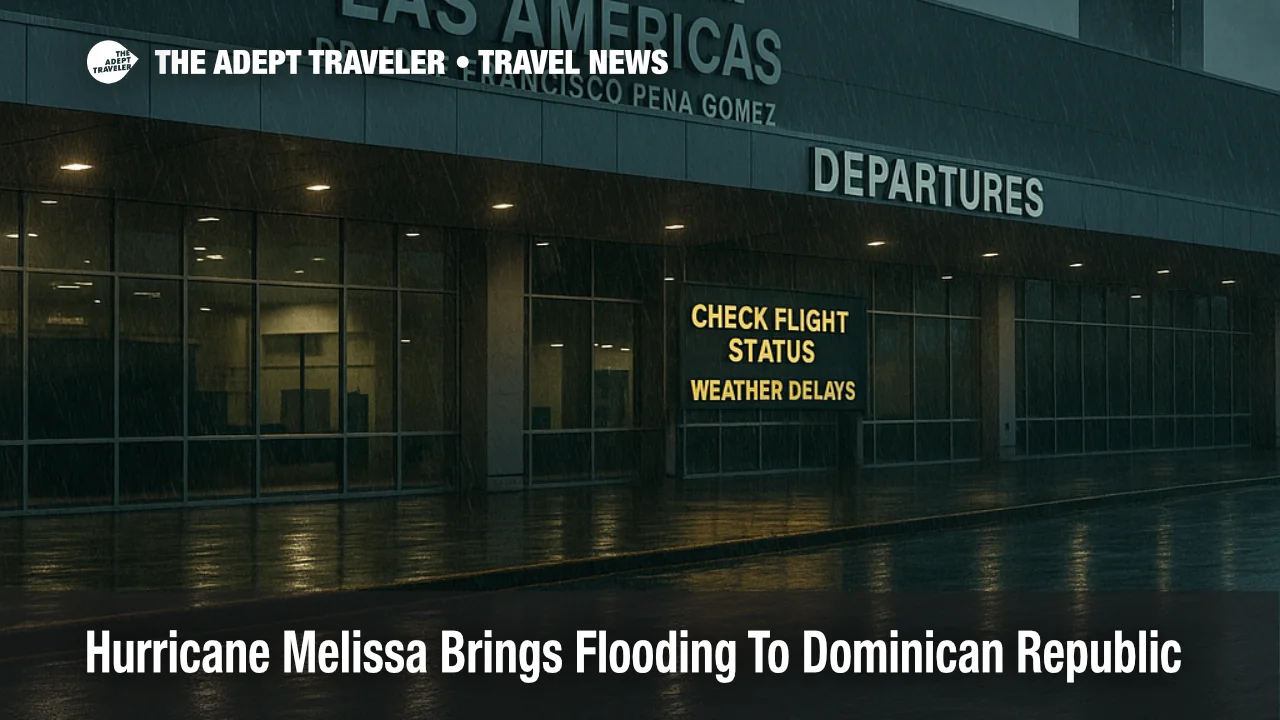Hurricane Melissa Brings Flooding To Dominican Republic

Key points
- Melissa brushed the Dominican Republic on October 28 with intense rain, flooding, and landslides
- Emergency Operations Center maintained province alerts and reported isolated sheltering and infrastructure impacts
- Airports operated largely normally during the peak period, though contingency measures were activated
- Two storm-related deaths and thousands temporarily displaced were reported by regional health authorities
- As of October 31, Melissa is moving away from the region and transitioning to extratropical
Impact
- Flights
- Most commercial flights operated without widespread cancellations, but travelers should still check status and allow extra time
- Airports
- Operations at Las Américas and other Aerodom fields remained largely normal with contingency teams active
- Roads & Flooding
- Localized road closures and landslides may delay airport transfers and intercity travel in southern and central provinces
- Power & Services
- Scattered power and water interruptions affected services and some facilities; resources are being restored
- What To Do
- Confirm flight status with your airline, monitor COE alerts, and avoid flooded areas until authorities clear routes
Hurricane Melissa delivered a day of dangerous rainfall across the Dominican Republic on October 28, pushing rivers over their banks and triggering landslides in several southern and central provinces. The country's Emergency Operations Center, COE, held province-level alerts while health and civil-protection teams addressed localized flooding, power interruptions, and isolated sheltering. Regional tallies indicate at least two storm-related fatalities in the Dominican Republic and several thousand people temporarily displaced as assessments continue.
Situation on the ground
Melissa's core skirted the southern coast as a major hurricane on October 28, concentrating impacts in provinces south and center of the island. COE situation reports over October 26-29 kept multiple provinces under red, yellow, and green alerts as bands of heavy rain persisted, with instructions for preventive evacuations in the most flood-prone areas.
A Pan American Health Organization (PAHO) regional situation report released October 30 summarizes impacts in the Dominican Republic: two deaths, thousands displaced or sheltered, and disruptions from flooding and landslides. PAHO also notes service interruptions at several medical facilities due to roof leaks, partial flooding, or blocked access as waters rose.
While the storm's worst winds targeted Jamaica and later eastern Cuba, Dominican authorities emphasized hydrological risks. U.S. Embassy alerts for Santo Domingo on October 21-23 amplified the COE guidance, citing red alerts for many provinces and advising residents to avoid flooded zones and monitor official updates.
Airport and airline operations
Despite periods of intense rain, airports managed to keep most flights moving. Aeropuertos Dominicanos Siglo XXI (Aerodom), the operator for the country's main state-managed airports, reported normal operations during the peak period as Melissa passed, while activating emergency protocols and urging passengers to check with airlines. Local and English-language reports the weekend prior to Jamaica's landfall corroborated that Aerodom terminals had no mass cancellations at that stage.
On first mention, the capital region's gateway is Las Américas International Airport, Dr. José Francisco Peña Gómez (SDQ). Other key gateways include Punta Cana International Airport (PUJ), Cibao International Airport (STI), and Gregorio Luperón International Airport (POP). Even with terminals open, travelers faced longer drive times due to high water on roadways and downed debris, especially south of the capital and into the interior. PAHO notes temporary access issues to some health facilities from flooding and fallen material, underscoring broader transport challenges during and immediately after the event.
Latest developments
By early October 31, the National Hurricane Center reported Melissa accelerating away from Bermuda and forecast a transition to an extratropical system later today. That track removes the immediate tropical cyclone threat to Hispaniola, though residual flooding, landslide risk in saturated terrain, and marine hazards may linger into the weekend.
U.S. carriers maintained storm-response pages and change-fee guidance across the Caribbean during the week. Travelers headed to or from the Dominican Republic should continue to verify waivers and rebooking rules, which may vary by ticket type, dates, and airports covered.
Analysis
For travelers, Melissa's Dominican Republic phase was primarily a hydrological emergency. That matters operationally because rainfall impacts are uneven: one highway may be impassable while nearby routes remain open, and airport operations can continue even as curbside access slows. The takeaway is practical, not dramatic: verify your route to the airport, pad your schedule, and keep an eye on provincial alerts for renewed bands of rain.
Background. COE is the country's interagency emergency coordinator, issuing color-coded alerts and guidance. PAHO provides regional health-impact coordination and reporting that frequently outlasts the news cycle, which is useful for judging residual risk to infrastructure and services after the center of a storm departs. The National Hurricane Center remains the authoritative source for storm track and intensity.
Final thoughts
Hurricane Melissa's core spared the Dominican Republic a direct hit, however the storm still produced serious flooding and service disruptions. As recovery continues, keep monitoring COE updates and airline advisories, and use confirmed, open routes for airport transfers. With Melissa now moving away, the focus shifts from wind to water and from warnings to repairs.
Sources
- PAHO Regional Situation Report, Hurricane Melissa, October 30, 2025 (PDF)
- PAHO Regional Situation Report, Hurricane Melissa - Landing Page
- Informe de Situación 1: Dominicana, Huracán Melissa - 29 Oct 2025 (PAHO/OPS)
- COE, Informe de Situación No. 18, Huracán Melissa - 29 Oct 2025, 8 AM
- National Hurricane Center, Hurricane Melissa - Public Advisory (Advisory 40)
- Aerodom Responds To Effects Of Storm Melissa, "No Flights Have Been Canceled" (Dominican Today)
- American Airlines - Tropical Storm Melissa, Special Exception Policy (SalesLink)
